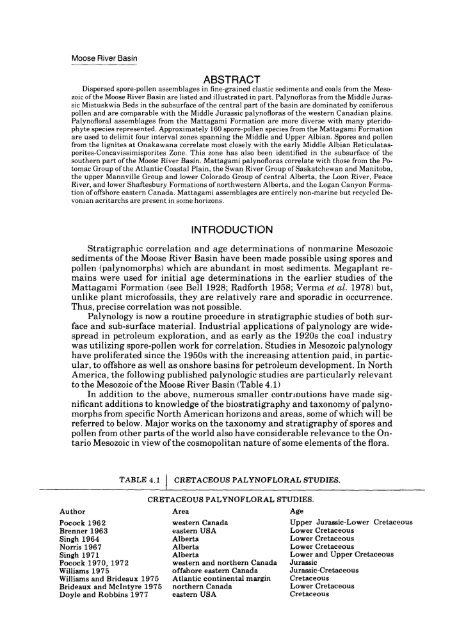Moose River Basin: geology and mineral potential - Geology Ontario
Moose River Basin: geology and mineral potential - Geology Ontario
Moose River Basin: geology and mineral potential - Geology Ontario
Create successful ePaper yourself
Turn your PDF publications into a flip-book with our unique Google optimized e-Paper software.
<strong>Moose</strong> <strong>River</strong> <strong>Basin</strong><br />
ABSTRACT<br />
Dispersed spore-pollen assemblages in fine-grained clastic sediments <strong>and</strong> coals from the Meso<br />
zoic of the <strong>Moose</strong> <strong>River</strong> <strong>Basin</strong> are listed <strong>and</strong> illustrated in part. Palynofloras from the Middle Juras<br />
sic Mistuskwia Beds in the subsurface of the central part of the basin are dominated by coniferous<br />
pollen <strong>and</strong> are comparable with the Middle Jurassic palynofloras of the western Canadian plains.<br />
Palynofloral assemblages from the Mattagami Formation are more diverse with many pterido<br />
phyte species represented. Approximately 160 spore-pollen species from the Mattagami Formation<br />
are used to delimit four interval zones spanning the Middle <strong>and</strong> Upper Albian. Spores <strong>and</strong> pollen<br />
from the lignites at Onakawana correlate most closely with the early Middle Albian Reticulatasporites-Concavissimisporites<br />
Zone. This zone has also been identified in the subsurface of the<br />
southern part of the <strong>Moose</strong> <strong>River</strong> <strong>Basin</strong>. Mattagami palynofloras correlate with those from the Potomac<br />
Group of the Atlantic Coastal Plain, the Swan <strong>River</strong> Group of Saskatchewan <strong>and</strong> Manitoba,<br />
the upper Mannville Group <strong>and</strong> lower Colorado Group of central Alberta, the Loon <strong>River</strong>, Peace<br />
<strong>River</strong>, <strong>and</strong> lower Shaftesbury Formations of northwestern Alberta, <strong>and</strong> the Logan Canyon Forma<br />
tion of offshore eastern Canada. Mattagami assemblages are entirely non-marine but recycled De<br />
vonian acritarchs are present in some horizons.<br />
INTRODUCTION<br />
Stratigraphic correlation <strong>and</strong> age determinations of nonmarine Mesozoic<br />
sediments of the <strong>Moose</strong> <strong>River</strong> <strong>Basin</strong> have been made possible using spores <strong>and</strong><br />
pollen (palynomorphs) which are abundant in most sediments. Megaplant re<br />
mains were used for initial age determinations in the earlier studies of the<br />
Mattagami Formation (see Bell 1928; Radforth 1958; Verma et al. 1978) but,<br />
unlike plant microfossils, they are relatively rare <strong>and</strong> sporadic in occurrence.<br />
Thus, precise correlation was not possible.<br />
Palynology is now a routine procedure in stratigraphic studies of both sur<br />
face <strong>and</strong> sub-surface material. Industrial applications of palynology are wide<br />
spread in petroleum exploration, <strong>and</strong> as early as the 1920s the coal industry<br />
was utilizing spore-pollen work for correlation. Studies in Mesozoic palynology<br />
have proliferated since the 1950s with the increasing attention paid, in partic<br />
ular, to offshore as well as onshore basins for petroleum development. In North<br />
America, the following published palynologic studies are particularly relevant<br />
to the Mesozoic of the <strong>Moose</strong> <strong>River</strong> <strong>Basin</strong> (Table 4.1)<br />
In addition to the above, numerous smaller contributions have made sig<br />
nificant additions to knowledge of the biostratigraphy <strong>and</strong> taxonomy of palyno<br />
morphs from specific North American horizons <strong>and</strong> areas, some of which will be<br />
referred to below. Major works on the taxonomy <strong>and</strong> stratigraphy of spores <strong>and</strong><br />
pollen from other parts of the world also have considerable relevance to the On<br />
tario Mesozoic in view of the cosmopolitan nature of some elements of the flora.<br />
TABLE 4. l<br />
CRETACEOUS PALYNOFLORAL STUDIES.<br />
CRETACEOUS PALYNOFLORAL STUDIES.<br />
Author Area Age<br />
Pocock 1962 western Canada Upper Jurassic-Lower Cretaceous<br />
Brenner 1963 eastern USA Lower Cretaceous<br />
Singh 1964 Alberta Lower Cretaceous<br />
Norris 1967 Alberta Lower Cretaceous<br />
Singh 1971 Alberta Lower <strong>and</strong> Upper Cretaceous<br />
Pocock 1970, 1972 western <strong>and</strong> northern Canada Jurassic<br />
Williams 1975 offshore eastern Canada Jurassic-Cretaceous<br />
Williams <strong>and</strong> Brideaux 1975 Atlantic continental margin Cretaceous<br />
Brideaux <strong>and</strong> Mcintyre 1975 northern Canada Lower Cretaceous<br />
Doyle <strong>and</strong> Robbins 1977 eastern USA Cretaceous

















